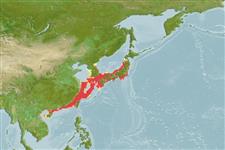Common names from other countries
Classification / Names / Names
Common names | Synonyms | Catalog of Fishes (gen., sp.) | ITIS | CoL | WoRMS
Environment: milieu / climate zone / depth range / distribution range
Ecology
Benthic; non-migratory (Ref. 75927); depth range 0 - 150 m (Ref. 96968), usually 30 - 150 m (Ref. 75927). Temperate
Northwest Pacific. Subtropical to temperate.
Length at first maturity / Size / Weight / Age
Maturity: Lm ? range ? - ? cm Max length : 20.0 cm TL male/unsexed; (Ref. 96968); max. published weight: 100.00 g (Ref. 96968); max. reported age: 1.00 years (Ref. 126599)
A small species with an ocellus on each side of the arm crown which contains a narrow, large-diameter, iridescent ring. The iridescent ring typically appears to be gold or metallic green in color. A light orange, broad, rectagular bar can also be seen on the head.
Maximum depth from Ref. 97927. Its mantle length is 8 cm (Ref. 96968).
Life cycle and mating behavior
Maturity | Reproduction | Spawning | Eggs | Fecundity | Larvae
Members of the class Cephalopoda are gonochoric. Male and female adults usually die shortly after spawning and brooding, respectively. Mating behavior: Males perform various displays to attract potential females for copulation. During copulation, male grasp the female and inserts the hectocotylus into the female's mantle cavity where fertilization usually occurs. Life cycle: Embryos hatch into planktonic stage and live for some time before they grow larger and take up a benthic existence as adults.
Bisby, F.A., M.A. Ruggiero, K.L. Wilson, M. Cachuela-Palacio, S.W. Kimani, Y.R. Roskov, A. Soulier-Perkins and J. van Hertum. 2005. (Ref. 19)
IUCN Red List Status (Ref. 130435: Version 2024-1)
CITES status (Ref. 108899)
Not Evaluated
Not Evaluated
Human uses
Fisheries: bycatch
| FishSource |
Tools
Internet sources
Estimates based on models
Vulnerability
Low vulnerability (10 of 100).
